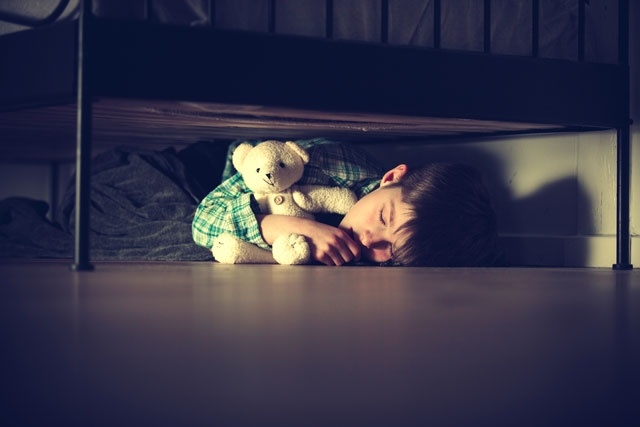
Early care and education professionals know that even very young children may face overwhelming situations in their lives.
According to the National Child Traumatic Stress Network, by the time they’re 16, 25 percent of youth will experience a potentially traumatic event, such as natural disaster, severe illness/injury, rape, physical assault, family or community violence, terrorism or war-related stressors, or the sudden loss of a caregiver or loved one.
Maybe a child in your classroom has talked about going through a very hard time. Or maybe their behavior makes you suspect “something happened”—something bad—but you don’t know what. In either case, you may not feel well-prepared to help them.
When I taught young children, there were several times when my colleagues and I wanted to help an obviously distressed child but were uncertain what to do. For me, a good first step was getting informed about children’s stress and trauma in general.
This is the first of two blog posts about that topic.
Ways of looking at childhood stress and trauma
The concept of adverse childhood experiences, or ACEs, helps clarify how some events affect children’s mental and emotional well-being. ACEs are “stressful or traumatic events that occur early in a child’s life or through chronic exposure.” As a category, ACEs does not cover all potentially traumatic events, but getting familiar with the concept is a good start for understanding childhood trauma.
A child’s daily life may be full of incidents that cause mild stress, such as meeting new people, facing a challenging task, and having a cold. Children generally get through them on their own or with a little support from the adults around them.
Tolerable stress is more serious and tends to be related to unusual events, such as natural disasters, serious illness or injury, or disruptions to family life. Over time, and with support from significant people in their lives, most children can manage or recover.
Toxic stress involves serious, frequent, and/or prolonged adversity, such as ongoing abuse, chronic neglect, caregiver substance abuse or mental illness, exposure to violence, family poverty, or homelessness. A key factor in toxic stress is the combination of potentially traumatic events and the lack of good support for the child within the family or community, which makes coping difficult, if not impossible. Research tells us that toxic stress can harm children’s brain development and overall physical and mental health.
Humans, including children, have built-in biological responses that help us survive dangerous events. We fight, we flee, or we freeze. All involve intense temporary changes in our bodies. When the stressful event ends, or when we get help, our bodies and minds no longer need that “high alert.” But if we perceive ongoing danger, or if no support is available, that high alert continues. A child in a toxic stress situation stays on high alert even after the perceived danger is over. So they may be worried or agitated even when others around them feel the situation is safe or calm.
You’ve probably heard the term PTSD: post-traumatic stress disorder. PTSD is a specific diagnosis, a condition in which (among other criteria) a person’s trauma response lasts more than six months after the stressful event. It’s possible for children to be diagnosed with PTSD, but most children who experience a potentially traumatic event aren’t generally diagnosed with it. However, they might still be very distressed and need extra support.
Another relevant term is trauma and stressor-related disorder (TSRD). The American Psychiatric Association’s Diagnostic Statistical Manual, 5th edition (DSM-5), views PTSD as one type of TSRD.
You might be surprised to learn that the American Psychiatric Association has not always considered child development factors in diagnosing PTSD! The DSM-5, published in 2013, for the first time changed some of its criteria for PTSD in children age 6 and under in line with knowledge of child development. This is good news. Previously, diagnosis relied on the same criteria used for adults.
So, what exactly is trauma?
The American Psychological Association defines trauma as “an emotional response to a terrible event like an accident, rape or natural disaster.” Early childhood professionals need to be aware that trauma exposure can occur in several ways:
- Direct: the child is personally harmed or at risk of harm.
- Witnessed: the child sees/hears harm to others, particularly a caregiver or family member.
- Indirect: the child is not present at the event, but learns afterward about harm to someone important to them.
The feelings of trauma
Trauma can result in feelings of horror, helplessness, and extreme fear. The intense sense of threat can easily overwhelm children so they can’t feel calm or safe about what has happened. They may cry, they may talk about the event—or they may go silent. Their play may reflect their feelings about the experience.
It’s essential to understand that children’s reactions to severe stress and trauma can be complex. They don’t simply “get over it” or “move on.” Research has shown over and over that children’s ability to cope with and recover from trauma depends strongly on the presence of protective factors, such as caring and supportive people in their lives. Resilience to stress comes partly from within, but children healing from trauma need adults sensitive to their distress AND to their inner strengths.
In a later blog, I’ll talk about signs of trauma in young children and ways early childhood programs and providers can support children experiencing trauma.
IEL Resources
Web Resources
-
ACEs and Toxic Stress: Frequently Asked Questions
Source: Center on the Developing Child (Harvard University)
This document provides answers to questions about Adverse Childhood Experiences (ACEs).
-
The National Child Traumatic Stress Network
Source: National Child Traumatic Stress Network
The mission of the National Child Traumatic Stress Network is to raise the standard of care and improve access to services for traumatized children, their families, and communities throughout the United States.
-
Toxic Stress
Source: Center on the Developing Child (Harvard University)
This resource offers a definition of toxic stress and describes how it can influence learning, behavior, and health throughout the lifespan


 Printer-friendly PDF
Printer-friendly PDF Jean Mendoza
Jean Mendoza
 Printer-friendly PDF
Printer-friendly PDF